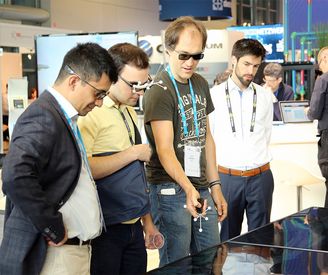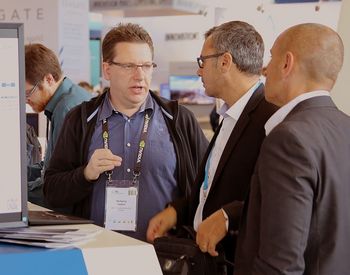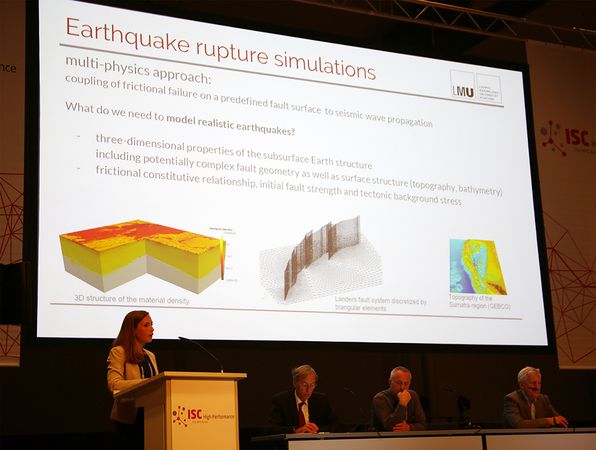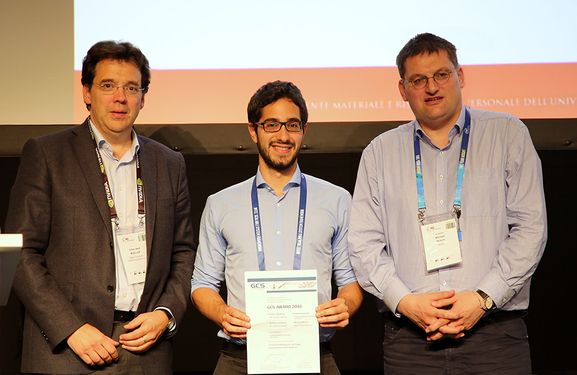NEWSFLASHES
GCS teams attend ISC 2016 in Frankfurt/Main
Newsflash –

The GCS booth at ISC16.
Copyright: GCSAt this year’s International Supercomputing Conference ISC'16 held in Frankfurt/Main (June 19 - 23), the 64 m2 large booth of the Gauss Centre for Supercomputing (booth #1310) proved once again to be the pivotal platform for the international scientific and industrial HPC community. The open and enticing layout of the booth, designed to encourage the ISC attendees to stop by at the GCS booth and interchange with the representatives of the GCS centres HLRS (High Performance Computing Center Stuttgart), JSC (Jülich Supercomputing Centre), and LRZ (Leibniz Supercomputing Centre, Garching/Munich) has again paid off. It attracted countless like-minded researchers, technology leaders, and scientists, amongst other visitors interested in HPC technologies and activities.
GCS Exhibition Highlights
The Virtual Reality (VR) presentation set up on the booth by the visualisation team of the HLRS revealed to be a true eye catcher for ISC attendees. HLRS scientists had used a 3D tiled display in table configuration to interactively investigate data acquired from CT or MRI scans in combination with biomechanical simulations of bone implant compounds, blood flow simulations, as well as anatomical structures and forensic data. One of the demonstrations displayed clinical CT-data of a trauma patient. A second demonstration displayed the 3D-image acquired from the torso of a crime victim who had been shot three times and killed. Visitors were able to observe the virtually recreated body structures from all different angles and follow the explanations by the HLRS scientists regarding the analysis and derived insights of the biomechanical simulation results or the reconstruction of the crime scenario.
Extremely well received were also the ISC exhibits arranged by the JSC team. JSC's in-house developed supercomputing applications and tools, in particular LLview, the interactive monitoring software for supercomputers which demonstrated live the operation of various supercomputers worldwide, found an enormous level of interest. Video showcases of the third GCS member LRZ, presenting SuperMUC user projects respectively activities related to energy efficient data centre management and operation, completed the presentations on the GCS booth which provided a comprehensive demonstration of the wide spectrum of challenging HPC activities the GCS is involved in, underlining GCS's role as a global leader in high performance computing.
ISC Conference - Workshops, Sessions, Tutorials
In addition to its presentations on the exhibition floor of the ISC, GCS contributed to the HPC conference with numerous talks and presentations in various tutorials and sessions, workshops, and birds-of-a-feather meetings. One of the highlights, brought to the ISC attendees by GCS, was the special conference session Advanced Disaster Prediction and Mitigation, hosted by Prof. Arndt Bode of the LRZ. Three users introduced their research projects, which they had carried out on the GCS HPC systems Hazel Hen, JUQUEEN, and SuperMUC, provided detailed insight into the challenges of their undertakings and presented their up to now achieved results:
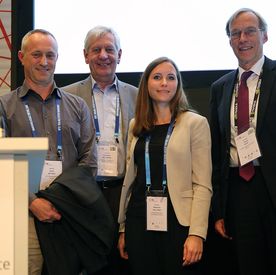
from left: Armin Seyfried, Christoph Kottmeier, Stephanie Wollherr, and session chairman Arndt Bode.
Copyright: GCS- Safety in the Underground – Coupling CFD with Pedestrian Simulations
Prof. Dr. Armin Seyfried, Jülich Supercomputing Centre & University of Wuppertal - Large-Scale Multi-Physics Earthquake Scenarios with the ADER-DG Method on Modern Supercomputers
Stephanie Wollherr, Ludwig-Maximilians-Universität München - Advancing Numerical Weather Prediction & Downscaling Global Climate Models with Emphasis on Weather Extremes
Prof. Dr. Christoph Kottmeier, Karlsruhe Institute of Technology/KIT
Additionally, representatives of the GCS centres supported activities of GCS partners and/or related HPC initiatives, such as by the Partnership for Advanced Computing in Europe (PRACE), European Exascale Projects (DEEP/DEEP-ER, Mont-Blanc, EXDCI), the two European Centres of Excellence CoeGSS and POP, the Jülich-Aachen Research Alliance (JARA), the UNICORE Forum, and others.
ISC’16 GCS Award
At ISC's Research Paper session, Prof. Michael M. Resch, Director of the HLRS, was very pleased to put the spotlight on a young and bright researcher of the University of Bologna. The paper Predictive Modeling for Job Power Consumption in HPC Systems, written and submitted by Mr. Andrea Borghesi (University of Bologna) and his team of five, had been selected by the International Award Committee as the most outstanding research paper submitted at this year's ISC and thus was honoured with the coveted GCS Award 2016. The paper focuses on methods to accurately predict the power consumption of typical supercomputer workloads and provides insight into how to implement and successfully execute power-saving techniques to real working environments. Prof. Resch as chairman of the award committee and Dr. Claus Axel Müller, Managing Director of GCS, handed the award certificate over to Mr. Borghesi, who had introduced his very interesting work to the attentively following large audience attending this ISC research paper session.
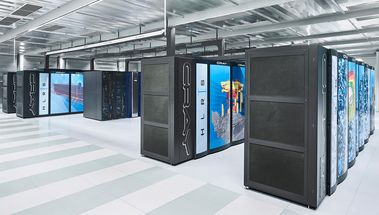
Hazel Hen of HLRS (a CRAY XC40 system) delivers a Linpack performance of 5.64 Petaflops.
Copyright: Boris Lehner for HLRSTOP500
While the Chinese supercomputer Sunway TaihuLight, the new #1 on the 47th edition of the TOP500 list revealed at ISC'16, surprised the global HPC community with its impressive Linpack performance of 93 Petaflops (Rmax), GCS is proud to emphasize that its supercomputing installations Hazel Hen (at HLRS), JUQUEEN (at JSC), and SuperMUC Phase 1 and Phase 2 (at LRZ) continue to represent significant positions in the TOP500. In the list, which enumerates the world’s most powerful HPC systems world-wide, Hazel Hen is registered on position 9 (Linpack: 5.64 Petaflops) with which the HLRS supercomputer defended its ranking amongst the top-10 most powerful HPC systems world-wide. Despite being meanwhile in its 5th year of operation, JSC’s JUQUEEN holds an impressive 14th place with its Linpack performance of 5.01 Petaflops. The supercomputing installations at LRZ, SuperMUC Phase 1 on position #27 (Linpack: 2.90) and SuperMUC Phase 2 (#28, Linpack 2.81), complement the solid and strong outcome of the GCS HPC systems in the current TOP500 rankings. Combined, the GCS continues to provide the by far most powerful HPC platform in all of Europe for research in science and industry. Apart from its world-class performance, the GCS infrastructure excels at its complementary system technologies and architectures to meet the most demanding needs of the individual fields of research.
